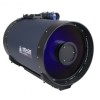Meade 16 inch Instruction Manual - Page 15
Too Much Power?
 |
View all Meade 16 inch manuals
Add to My Manuals
Save this manual to your list of manuals |
Page 15 highlights
Mounting Slot Track Thumbscrews Fig. 11: Viewfinder Assembly. GPS Receiver Collimation Screws Viewfinder Eyepiece Fig. 12: Viewfinder collimation screws and eyepiece. Tip: Because the space between the GPS receiver and the viewfinder is a bit tight, it is helpful if you tighten the front, bottom viewfinder collimation thumbscrew first and use the other screws to set the alignment. However, if you determine you need to adjust the front thumbscrew, choose an alignment object that allows you to slightly elevate or rotate the telescope to a convenient position for adjustment of this thumbscrew. Fig. 13a & 13b: Jupiter; examples of the right amount of magnification and too much magnification. The power, or magnification of a telescope is determined by the focal length of the telescope and the focal length of the eyepiece being used (an eyepiece's focal length is printed on the side of the eyepiece). To calculate eyepiece power, divide the telescope's focal length by the eyepiece's focal length. For example: A 26mm eyepiece is supplied with LX200GPS models. The focal length of the 8" f/10 LX200GPS is 2000mm (see SPECIFICATIONS, pages 47 through 49). Eyepiece Power = Telescope focal length ÷ Eyepiece focal length Eyepiece Power = 2000mm ÷ 26mm Eyepiece Power = 77 The eyepiece power, or magnification is therefore 77X (approximately). Note: For a list of magnification ratings of the eyepieces available for the LX200GPS telescopes, see OPTIONAL ACCESSORIES, page 41. Mounting and Adjusting the Viewfinder To align the viewfinder, perform steps 1 through 5 during the daytime; perform step 6 at night. 1. Slide the track on the bottom of the viewfinder into the slot in the viewfinder mounting assembly. See Fig. 11. To secure the viewfinder to the mounting assembly, tighten the two thumbscrews (Fig. 11) to a firm feel only. 2. If you have not already done so, insert the Super Plössl 26mm eyepiece into the diagonal prism. 3. Unlock the R.A. (12, Fig. 1) and Dec. (17, Fig. 1) locks so that the telescope moves freely on both axes. 4. Point the telescope at some well-defined and stationary land object at least 200 yards distant, such as the top of a telephone pole or street sign. Center the object in the telescope eyepiece. Re-tighten the R.A. and Dec. locks. 5. Look through the viewfinder eyepiece (Fig. 12) and loosen or tighten, as appropriate, one or more of the viewfinder collimation screws (Fig. 12) until the viewfinder crosshairs are precisely centered on the object you previously centered in the telescope eyepiece. 6. Check this alignment on a celestial object, such as the Moon or a bright star, and make any necessary refinements, using the method outlined in steps 3 through 5. Note: Seeing conditions vary widely from night-to-night and site-to-site. Turbulence in the air, even on an apparently clear night, can distort images. If an image appears fuzzy and ill-defined, back off to a lower power eyepiece for a more well-resolved image (see Fig. 13a and 13b). LX200GPS TIPS Too Much Power? Can you ever have too much power? If the type of power you're referring to is eyepiece magnification, yes, you can! The most common mistake of the beginning observer is to "overpower" a telescope by using high magnifications which the telescope's aperture and atmospheric conditions cannot reasonably support. Keep in mind that a smaller, but bright and well-resolved image is far superior to one that is larger, but dim and poorly resolved (see Figs. 13a and 13b). Powers above 400X should be employed only under the steadiest atmospheric conditions. Autostar II can calculate the best eyepiece for you to use. Try out the "Eyepiece Calc" feature in the Utilities menu. Most observers should have three or four additional eyepieces to achieve the full range of reasonable magnifications possible with the LX200GPS telescopes. See OPTIONAL ACCESSORIES, page 41. 15















